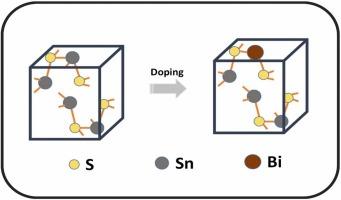High-performance Bi-doped SnS thin films: A route to enhanced thermoelectric power for miniaturized devices
IF 6.4
2区 工程技术
Q1 MECHANICS
International Communications in Heat and Mass Transfer
Pub Date : 2025-10-02
DOI:10.1016/j.icheatmasstransfer.2025.109759
引用次数: 0
Abstract
This study investigates the thermoelectric performance of bismuth (Bi)-doped tin sulfide (SnS) thin films synthesized via thermal evaporation. The pure SnS films exhibited limited thermoelectric efficiency due to low charge carrier concentration and electrical conductivity. To overcome this, Bi was incorporated into the SnS lattice at varying doping concentrations (0.1 %–0.3 %), leading to notable improvements in charge carrier concentration, Seebeck coefficient, and power factor. The SnS film doped with 0.1 % Bi exhibited a maximum Seebeck coefficient of −249.5 μV/K at 450 K. The highest thermoelectric power factor of 4.42 μW cm−1 K−2 was achieved for the 0.3 % Bi-doped film at 450 K, resulting from an optimized balance between electrical conductivity (42.5 S/cm) and a stable Seebeck coefficient (−214 μV/K). X-ray diffraction (XRD) confirmed the phase purity and successful Bi incorporation without secondary phase formation, while scanning electron microscopy (SEM) revealed the evolution of nano-wedge-shaped grains with increasing Bi content. Energy-dispersive X-ray spectroscopy (EDS) verified the elemental composition and uniform Bi distribution, and Hall effect measurements provided insights into the carrier mobility and concentration. These results demonstrate that low-concentration Bi doping effectively enhances the thermoelectric performance of SnS thin films and offers a promising route for developing efficient thin-film thermoelectric materials.

高性能双掺杂SnS薄膜:增强小型化器件热电功率的途径
研究了热蒸发法制备的掺铋硫化锡(sn)薄膜的热电性能。纯SnS薄膜由于载流子浓度低、电导率低,热电效率有限。为了克服这个问题,在不同掺杂浓度(0.1% - 0.3%)下将Bi掺入到SnS晶格中,从而显著改善了载流子浓度、塞贝克系数和功率因数。在450 K时,掺0.1% Bi的SnS薄膜的塞贝克系数最大,为−249.5 μV/K。在450k温度下,掺杂了0.3%铋的薄膜获得了最高的热电功率因子4.42 μW cm−1 K−2,这是由于电导率(42.5 S/cm)和稳定的塞贝克系数(- 214 μV/K)之间的最佳平衡。x射线衍射(XRD)证实了相纯度和Bi的成功掺入,没有形成二次相,扫描电镜(SEM)显示随着Bi含量的增加,纳米楔形颗粒的演变。能量色散x射线光谱(EDS)验证了元素组成和均匀的Bi分布,霍尔效应测量提供了载流子迁移率和浓度的见解。这些结果表明,低浓度Bi掺杂有效地提高了SnS薄膜的热电性能,为开发高效薄膜热电材料提供了一条有前途的途径。
本文章由计算机程序翻译,如有差异,请以英文原文为准。
求助全文
约1分钟内获得全文
求助全文
来源期刊
CiteScore
11.00
自引率
10.00%
发文量
648
审稿时长
32 days
期刊介绍:
International Communications in Heat and Mass Transfer serves as a world forum for the rapid dissemination of new ideas, new measurement techniques, preliminary findings of ongoing investigations, discussions, and criticisms in the field of heat and mass transfer. Two types of manuscript will be considered for publication: communications (short reports of new work or discussions of work which has already been published) and summaries (abstracts of reports, theses or manuscripts which are too long for publication in full). Together with its companion publication, International Journal of Heat and Mass Transfer, with which it shares the same Board of Editors, this journal is read by research workers and engineers throughout the world.

 求助内容:
求助内容: 应助结果提醒方式:
应助结果提醒方式:


